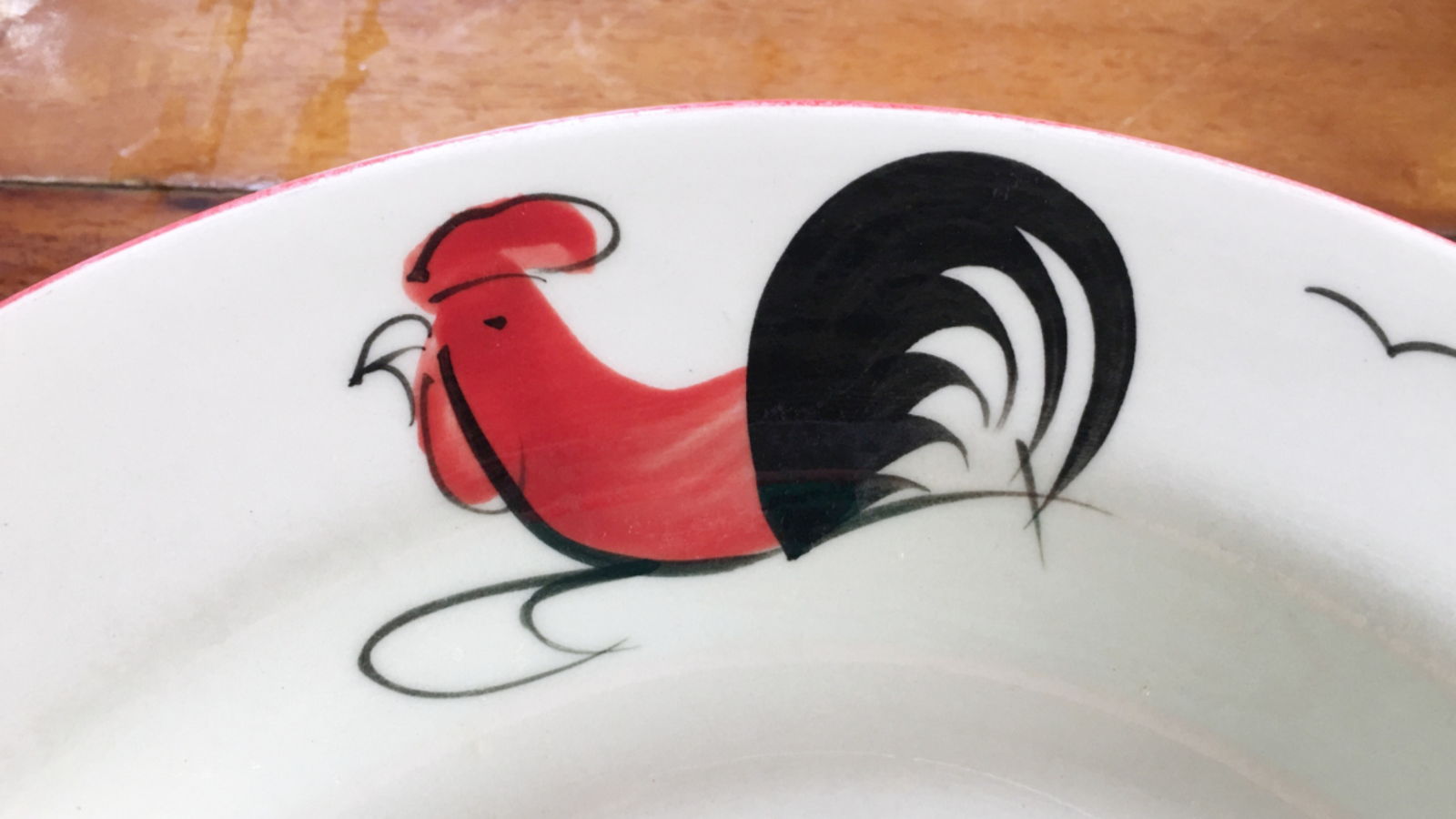As Singaporeans, Indonesians, Malaysians or Thai nationals, the rooster bowls at food stalls might be a familiar sight. The infamous bowl is often used to serve both rice and noodles dishes. I was pleasantly surprised to know that this bowl is even widely known in Hong Kong and used to serve delicious local specialties. Although less common than before, rooster bowls are still used these days in food courts and Chinese restaurants.
For example, these bowls are used at noodle or chicken rice stalls in Singapore. However, the rooster bowls of today are usually plastic imitations for the sake of preserving the nostalgic design. It is rare to find an authentic porcelain rooster bowl these days. It is even regarded as a collector item. Mr. Lee from Ipoh, Malaysia is one of the many collectors who has always loved finding ceramics with this distinctive pattern since he was 9 years old.
The significance of the rooster design
The first rooster bowls originated from China. They were made by the Hakka community around the Guangdong Province over a hundred years ago. Designs were drawn onto white bowls. Each bowl depicts a black-tailed rooster with a red neck and trunk walking on green grass. Red or purple peonies and green banana leaves were drawn on other side of the bowl.
Peonies symbolize wealth and high social status. The banana leaves signify fortune and luck. Just like most Chinese decorations, the drawings on the bowl represent the goodness in life. The choice of drawing a rooster instead of a hen speaks of the favoritism for males in the society back then.
First introduced in Thailand
Although the Hakka community from Guangdong may be the first to come up with the concept of rooster bowls, it is the Hakka community from Thailand that first manufactured them. Before the second World War, Chinese merchants in Bangkok would order the rooster bowls for sale because they were very cheap then. However, supplies ran short and prices soar during the war.
After the war ended, the manufacturers in Bangkok produced more bowls which soon became well-known utensils thanks to their durability. 1957 marked the start of a new rooster bowl factory in Lampang Province, Thailand. Hong Kong street food in particular made extensive use of these rooster bowls which then became a piece of fond memory to many.
There are a number of variations of the design of the rooster bowl. The very first rooster bowls were hand-painted, thus making them unique. When they began to be manufactured, the design was standardized consisting of a rooster, peony flower and banana tree. While the original rooster was red and black, the colours were later modified in 1962 to green with a blue tail. Some bowls from the Chinese province, Hunan are slightly different as they are painted in blue with finer strokes.
A common bowl in Chinese households
Rooster bowls were known for their above-average quality back in those days. They are an affordable alternative for those who could not afford the bowls of the upper class. The reason for a rooster design is probably because ‘rooster’ sounds like ‘family’ or ‘home’ in Hokkien, one of the Chinese dialects. As such, many felt that when they ate from a rooster bowl, they are wishing for prosperity in their household. Additionally, the peonies painted on the bowl represent a common Chinese saying – “花开富贵” which literally means the flowers blossom with richness or prosperity.
In the 1960s, rooster bowls were sold for ten cents a piece. Thus, they were very common in every household. Eating together as a family and community meant a lot to the Chinese. They are used to serve rice, soups and even alcohol. They would also use these bowls to serve their guests as means of wishing them prosperity and good fortune.
Perhaps the most distinctive feature of the bowl is the trademark rooster on the sides. However, these bowls are unlike regular rice bowls for they are fairly shallow with a wide mouth and small base. Part of their popularity is attributed to the ease of eating out of them with chopsticks. Hence, they were widely used after the Second World War. The authentic bowls are very durable which is another feature that caused them to be well-received.
Rooster bowls throughout Southeast Asia
As culture matured and the Hakka community migrated all over Southeast Asia, they brought their rooster bowls with them. Naturally, it was picked up by the Chinese immigrants of other dialects. They became widespread all over the region of Southeast Asia. Today, the imitation rooster design can still be found.
However, the art of making such a bowl in all its authenticity remains in Lampang, the origin of its manufacture and the only province that still continues to produce rooster bowls today. Although, a company in Indonesia claimed the trademark of the well known rooster print. One can be fined up to RP 2 billion (ca. 137,000 USD and/or jailed up to 5 years! If you’re looking for the bowls that came along with the Chinese immigrants, that would be tough. It is difficult to find an artisan who can craft original rooster bowls turning them into collectibles.
Despite the mass-production of rooster bowls today which reduced their commercial value, it remains heartwarming to see this legacy being carried on from its humble roots in Guangdong. Many Southeast Asians grew up using them and the sentimental value definitely cannot be compromised.
Rooster bowls were used in a number of Chinese media productions such as Stephen Chow’s movies or TVB (Hong Kong television company) series. They are, perhaps, a symbolic representation of an important piece of the Chinese culture and heritage.
If you pay a visit to Southeast Asia sometime, be sure to visit a local food court or street food stalls and keep an eye out for this unique bowl with the rooster design.
